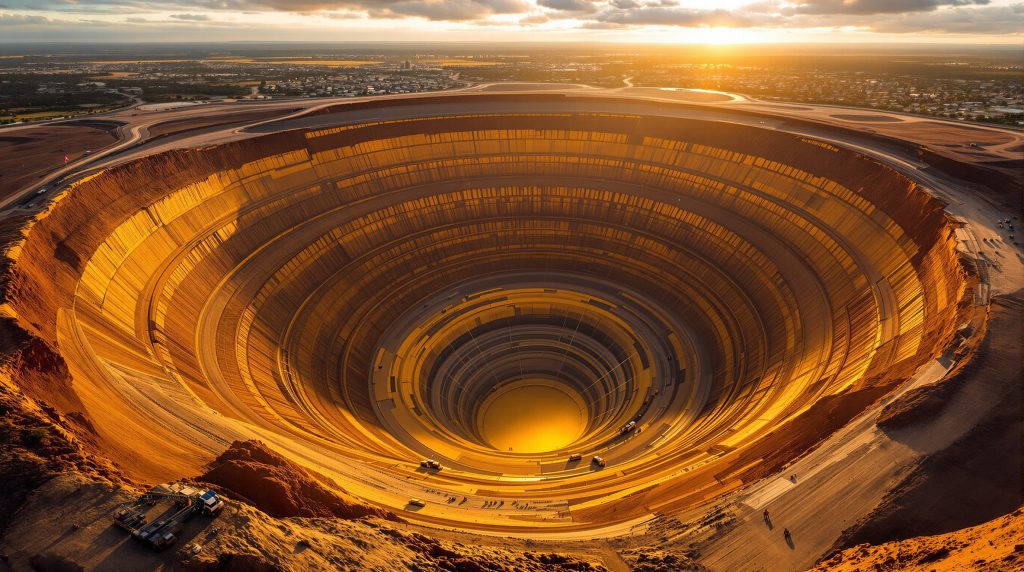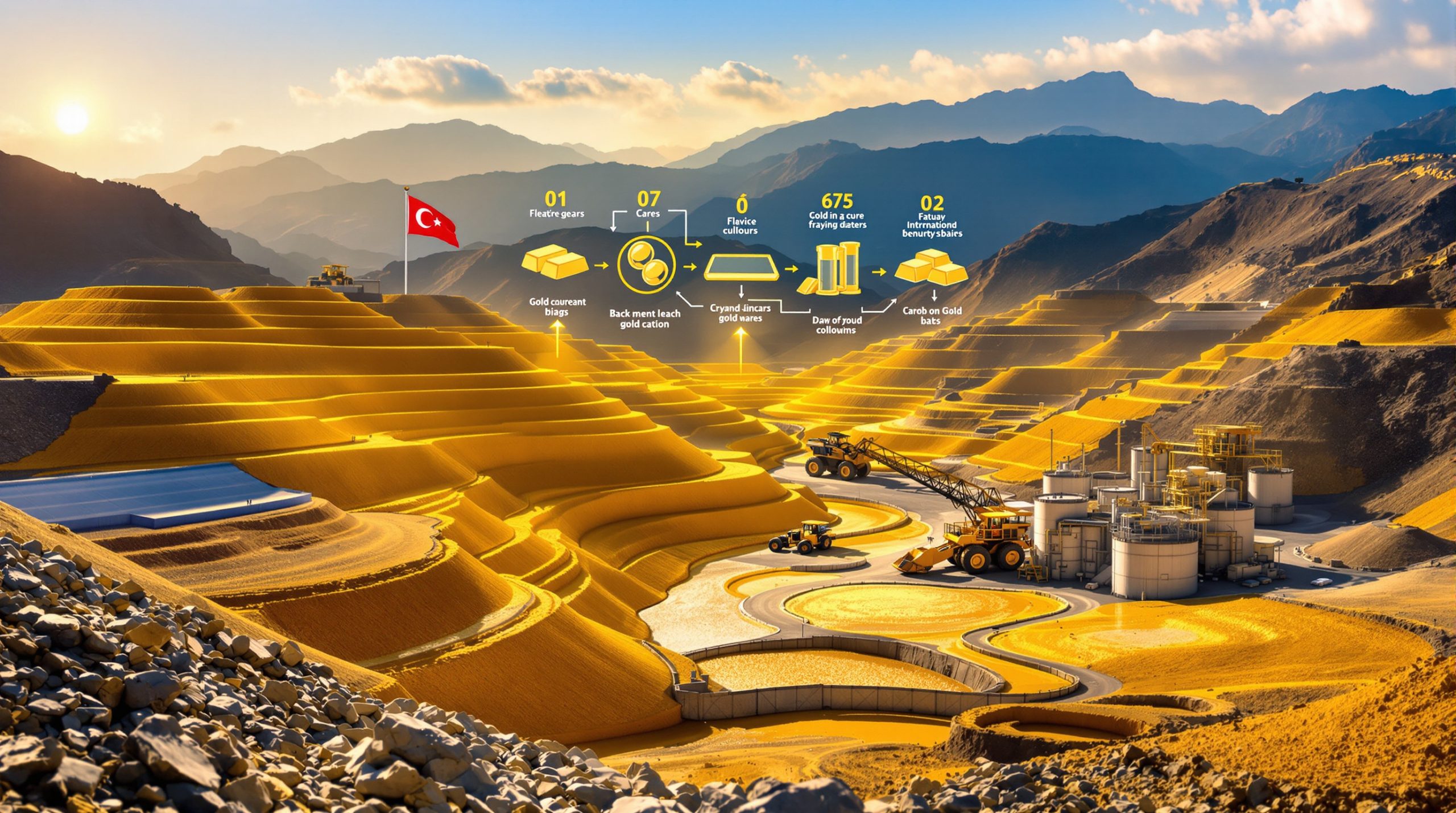The Evolution of Kalgoorlie's Super Pit: From Underground Networks to Open-Cut Giant
The transformation of Kalgoorlie's legendary Golden Mile from a network of underground mines into one of the world's most impressive open-cut operations stands as a testament to mining industry evolution and vision. This massive excavation, visible from space, has not only reshaped the physical landscape but also redefined the economic and social fabric of Western Australia's goldfields region.
The Golden Mile's Transformation
The Super Pit began operations in 1989, revolutionizing gold mining in Kalgoorlie by consolidating numerous smaller underground operations into a single massive open-cut mine. This bold approach represented a fundamental shift in how the historic goldfields would be worked for generations to come.
Today, the pit stretches approximately 3.5km in length and 1.5km in width, with depths exceeding 600 meters below the surface. This enormous scale allows for efficient extraction of gold from lower-grade ore bodies that would be uneconomical using traditional underground methods.
The operation typically produces around 800,000 ounces of gold annually, making it one of Australia's most significant gold producers and a cornerstone of the national mining industry.
Geological Significance of the Golden Mile
Kalgoorlie's Golden Mile earned its name honestly—the area represents one of Australia's richest gold-bearing regions, with distinctive mineralization patterns formed during intense geological activity over 2.7 billion years ago.
The region's unique geology features multiple intersecting ore bodies with varying gold concentrations throughout the deposit. This complex structural geology presented significant challenges to early mining approaches, with underground operations often competing for access to the richest veins.
Gold in the region occurs primarily in association with sulfide minerals within a network of quartz veins that cut through ancient greenstone belts. This geological complexity required increasingly sophisticated extraction methods as surface deposits were depleted.
How Did the Super Pit Come to Existence?
Alan Bond's Consolidation Vision
The Super Pit concept emerged from the entrepreneurial mind of Alan Bond in the early 1980s. As a businessman with diverse interests, Bond recognized an opportunity that mining specialists had overlooked—the inefficiency of multiple competing underground operations working the same geological formation.
Bond's ambitious vision involved consolidating the fragmented mining leases that had characterized the Golden Mile for nearly a century. This required navigating complex ownership structures, some dating back to the original gold rush era.
Through strategic acquisitions and negotiations, Bond gradually united the competing interests under a single operational umbrella. This mining consolidation strategies overcame significant regulatory hurdles and entrenched ownership rivalries that had historically prevented a unified approach to the Golden Mile.
From Concept to Reality
Between 1985 and 1987, extensive feasibility studies demonstrated the potential viability of a massive open-cut operation. These studies mapped historical workings, assessed ore quality at various depths, and projected production rates under different operational scenarios.
Environmental impact assessments identified numerous challenges, including the management of historical mining waste, water table impacts, and community concerns about dust and noise. These evaluations also revealed opportunities for improved safety and resource recovery compared to underground methods.
Construction commenced in 1988 with unprecedented earth-moving operations, requiring specialized equipment brought in from around the world. The first gold pour from the consolidated operation occurred in 1989, marking the beginning of a new era in Australian gold mining.
The initial development required investment exceeding $400 million—an extraordinary sum for the time that reflected both the project's ambition and its anticipated returns.
What Mining Methods Were Used Before the Super Pit?
The Underground Era (1893-1989)
Prior to the Super Pit's creation, the Golden Mile featured a labyrinthine network exceeding 3,500 kilometers of underground tunnels and shafts. This vast subterranean maze developed over nearly a century as miners pursued rich gold veins deep beneath the surface.
At its peak, more than 100 separate mining operations worked simultaneously across the area, often with competing claims and overlapping territories. This created significant inefficiencies and occasionally dangerous conditions as mines encountered each other's workings unexpectedly.
Early operations relied on manual drilling and blasting techniques, with miners working in extremely challenging conditions. The introduction of pneumatic drills, improved explosives, and mechanical ore transport gradually improved efficiency through the 20th century.
Despite technological improvements, underground mining in the Golden Mile faced persistent challenges with ventilation, ground support, and water management. These factors limited productivity and increased operational costs as mines reached greater depths.
Transition Challenges
Converting from underground to open-cut mining presented formidable engineering challenges. Engineers needed to assess the stability of historical workings, many poorly documented, that honeycombed the ground beneath the proposed pit.
Dewatering requirements for the massive excavation demanded sophisticated pumping systems capable of managing millions of liters daily. This water needed treatment before release, adding another layer of operational complexity.
The management of collapse zones where historical workings had deteriorated presented significant safety challenges. Detailed mapping using emerging technologies helped identify high-risk areas requiring special attention during excavation.
Perhaps equally challenging was the cultural shift required for a workforce accustomed to underground techniques. Many miners needed retraining to operate the large surface equipment that would replace traditional underground methods.
The broader community also faced adaptation challenges as the mining landscape transformed from relatively unobtrusive underground operations to a massive, visible excavation that would permanently alter the local geography.
What Economic Impact Did the Super Pit Create?
Employment and Community Transformation
The Super Pit's construction generated approximately 1,000 direct jobs during the initial development phase, providing significant economic stimulus to the Kalgoorlie region. As operations stabilized, the mine sustained employment for 700-800 workers throughout its productive life.
Beyond direct employment, the operation fostered the development of specialized mining skills and technical expertise that benefited the broader Australian resources sector. Many mining professionals gained valuable experience at the Super Pit before applying their knowledge at operations worldwide.
The economic impact extended well beyond the mine boundary, with significant flow-on effects for local businesses and service providers. From equipment maintenance to hospitality services for the mining workforce, the Super Pit created a diverse economic ecosystem.
An unexpected economic benefit emerged through tourism, with the iconic mining landmark attracting visitors fascinated by the scale of the operation. The lookout platform established in 1989 quickly became one of the region's most popular tourist destinations.
Financial Performance
The Super Pit's initial gold recovery rates exceeded pre-development projections by approximately 15%, vindicating the substantial investment required for its creation. This early success helped establish confidence in the open-cut approach.
Production costs decreased by approximately 30% compared to the previous underground methods, creating a more sustainable operation capable of processing lower-grade ore mining economics profitably. This efficiency improvement proved particularly valuable during periods of lower gold prices.
Since inception, the Super Pit's regional economic contribution has been estimated at over $25 billion, making it one of Western Australia's most significant single mining operations. This contribution includes direct production value, wages, local procurement, and tax revenues.
The operation's financial performance has naturally fluctuated with gold prices over its lifetime, requiring periodic operational adjustments. However, the flexibility of the open-cut approach has allowed the mine to remain profitable despite these market variations.
How Has Technology Evolved in the Super Pit?
Early Operational Equipment
When operations began in 1989, the Super Pit utilized what were then considered massive 170-tonne haul trucks—a scale of equipment previously unseen in Australian gold mining. These vehicles represented cutting-edge technology for their time but would eventually be dwarfed by later generations of mining equipment.
First-generation computer systems monitored production metrics but required significant manual data entry and offered limited real-time capabilities. These early systems laid the groundwork for the digital transformation that would follow.
Basic slope stability monitoring equipment provided essential safety information but lacked the precision and predictive capabilities of modern systems. Surveyors conducted regular manual measurements to complement electronic monitoring.
Conventional drill and blast techniques featured limited precision compared to today's methods, resulting in greater ore dilution and less efficient fragmentation. Blasting patterns were designed using relatively simple modeling techniques.
Gold recovery processes required significant human intervention at multiple stages, from ore selection to processing supervision. Laboratory analysis of ore samples guided production decisions but often involved time lags that affected operational efficiency.
Modern Mining Innovations
The Super Pit has progressively implemented autonomous haulage systems that allow trucks to operate without drivers, increasing safety and efficiency while reducing operational costs. These sophisticated systems use GPS, radar, and artificial intelligence to navigate the complex mining environment.
Advanced drill guidance and blast optimization technology now ensures precise hole placement and customized explosive charging based on detailed rock characteristics. This precision minimizes ore dilution and optimizes fragmentation for processing.
Real-time ore body modeling using sophisticated geological software allows operators to track grade variations with unprecedented accuracy. This capability enables dynamic mine planning that maximizes recovery of economic material.
Drone-based surveying and inspection capabilities have revolutionized site monitoring, providing detailed visual data without exposing personnel to potential hazards. These systems generate three-dimensional models that support planning and compliance activities.
Environmental management has benefited from enhanced monitoring systems that track dust levels, water quality, and noise in real-time. This modern mining technology enables immediate intervention when parameters approach compliance limits.
What Environmental Considerations Shaped the Super Pit?
Initial Environmental Challenges
When planning began, managing historical mining waste and contamination presented significant challenges. Decades of underground operations had left behind materials containing potentially harmful substances that required careful handling during excavation.
Dust control emerged as a critical concern given the pit's proximity to residential areas. Early operations implemented water spraying systems on haul roads and conveyor transfer points to minimize dust generation.
Water management in Kalgoorlie's semi-arid environment required careful planning to balance operational needs with conservation imperatives. The potential for groundwater contamination necessitated comprehensive monitoring systems.
Noise mitigation became essential for 24-hour operations, with strategic equipment placement and maintenance schedules designed to minimize community impact. Blast scheduling took into account residential considerations.
The visual impact of transforming natural landscapes into an industrial mining operation required sensitive management, including the preservation of buffer zones and strategic revegetation of non-operational areas.
Progressive Environmental Management
As operations matured, comprehensive waste rock management strategies evolved to categorize and segregate materials based on potential environmental impact. This approach minimized the risk of acid mine drainage and other environmental hazards.
Water recycling systems now capture over 80% of process water for reuse, significantly reducing fresh water consumption. Advanced treatment processes ensure that water discharged from the site meets or exceeds regulatory standards.
Native vegetation nurseries established on-site produce plants for progressive rehabilitation, using seeds collected from the local area to maintain genetic diversity. These facilities support ongoing mine reclamation innovation efforts as areas become available for rehabilitation.
Continuous air quality monitoring stations throughout Kalgoorlie provide real-time data on dust levels and other air quality parameters. This information enables immediate operational adjustments when conditions deteriorate.
Community consultation programs addressing environmental concerns have evolved from basic information sharing to collaborative problem-solving approaches. Regular public reporting of environmental performance builds transparency and trust.
Who Owned and Operated the Super Pit Over Time?
Ownership Evolution
Kalgoorlie Consolidated Gold Mines (KCGM) was established as the operating entity in 1989, creating a unified management structure for the consolidated Golden Mile operations. This arrangement streamlined decision-making and accountability.
The initial ownership structure included Normandy Mining and Homestake Mining, two companies with extensive gold mining experience. Their partnership provided the financial resources and technical expertise required for the ambitious project.
In the early 2000s, ownership transferred to Barrick Gold and Newmont Mining following industry consolidation. These global mining giants brought international best practices and access to capital for continued development.
A significant ownership change occurred in 2019 when Northern Star Resources and Saracen Mineral Holdings purchased the operation, returning control to Australian companies. This transition reflected the growing capability of Australian mining firms on the global stage.
The 2020 merger created consolidated ownership under Northern Star, simplifying management structures and creating opportunities for operational optimization. This arrangement continues to guide the operation's development.
Management Approaches
Throughout its history, the Super Pit has implemented international best practices in mining operations, often serving as a proving ground for approaches later adopted elsewhere. This commitment to excellence has supported consistent performance despite changing ownership.
Progressive community engagement strategies have evolved from traditional corporate philanthropy to more collaborative approaches focusing on shared value creation. These efforts recognize the mine's role as a community cornerstone.
Indigenous employment and business opportunities have received increasing emphasis, with dedicated programs supporting participation at all levels of the operation. Cultural awareness training ensures respect for traditional knowledge and values.
Adaptation to changing regulatory requirements has characterized management approaches, with proactive compliance strategies often exceeding minimum standards. This forward-looking approach has helped maintain the operation's social license.
Sustainability principles have become increasingly integrated into operational planning, with lifecycle considerations informing decisions from exploration to closure. This holistic perspective supports long-term value creation.
What Cultural and Heritage Aspects Were Affected?
Indigenous Connections
Recognition of traditional ownership by the Wangkathaa people has deepened over time, evolving from basic acknowledgment to meaningful engagement. This relationship acknowledges the profound connection between Indigenous people and the land.
Cultural heritage management plans developed in consultation with traditional owners guide the identification and protection of significant sites. These plans incorporate both archaeological assessment and traditional knowledge.
When significant cultural sites are identified, protection measures are implemented even when this requires operational adjustments. This approach demonstrates respect for cultural values beyond regulatory compliance.
Indigenous employment and training programs seek to create meaningful opportunities at all organizational levels. These initiatives recognize the importance of economic participation in supporting cultural continuity.
Collaborative approaches to land management and rehabilitation incorporate traditional ecological knowledge alongside scientific best practices. This integration enhances environmental outcomes while honoring cultural traditions.
Mining Heritage Preservation
The Super Pit's development necessitated careful documentation of historical mining techniques and equipment to preserve knowledge of earlier approaches. This documentation now forms an important historical record of Australian mining evolution.
Significant mining artifacts and structures have been preserved where possible, creating tangible connections to the region's mining heritage. Items that couldn't remain in place have been relocated to museums and heritage displays.
The Australian Prospectors and Miners Hall of Fame, established near the Super Pit, celebrates the industry's contribution to national development. This facility educates visitors about mining's historical importance and technical evolution.
Viewing platforms and tourism experiences allow visitors to witness modern mining operations while learning about historical approaches. These facilities attract thousands of visitors annually, supporting the local tourism economy.
Educational programs highlighting Kalgoorlie's mining history help maintain connections between past and present, ensuring that younger generations understand the region's gold mining heritage. These programs often include both classroom and site-based components.
How Has the Super Pit Shaped Modern Kalgoorlie?
Urban Development Impacts
The Super Pit's expansion occasionally required the relocation of residential areas, necessitating careful planning and community consultation. These transitions were managed to minimize disruption while improving housing quality where possible.
Infrastructure improvements including roads and utilities were often accelerated to support mining operations, benefiting the broader community. These investments enhanced regional connectivity and service reliability.
Specialized educational facilities for mining skills development emerged to meet industry needs, creating new career pathways for local residents. These institutions have evolved to support broader resource industry training beyond gold mining.
Support industries and services established to serve the Super Pit created economic diversification that reduced vulnerability to mining cycles. This broader economic base has strengthened community resilience during periods of industry fluctuation.
Buffer zones between mining and residential areas were established to minimize operational impacts while providing recreational opportunities. These green spaces enhance livability while serving practical environmental functions.
Community Identity
Kalgoorlie's identity has evolved from that of an underground mining town to a center for open-cut excellence, embracing this transition as part of its continuing mining story. This adaptive identity acknowledges both historical roots and contemporary reality.
Mining tourism has developed as an important economic diversification strategy, leveraging visitor interest in the Super Pit's impressive scale. This sector creates employment opportunities different from those in direct mining operations.
Community events and celebrations increasingly integrate mining heritage, reinforcing connections between industry and identity. These occasions build community cohesion while educating visitors about the region's mining foundations.
The growth of fly-in-fly-out workforce arrangements has presented both challenges and opportunities for community development. Local initiatives have focused on encouraging residential settlement and community participation.
Through multiple mining cycles and economic fluctuations, Kalgoorlie has demonstrated remarkable resilience, adapting to changing conditions while maintaining its fundamental character as a mining community. This adaptability speaks to the town's enduring connection to the resources sector.
What Does the Future Hold for the Super Pit?
Operational Outlook
Current mine life projections extend to approximately 2035, though this timeline may shift with exploration success or changes in gold price. Ongoing drilling programs continue to refine resource estimates and mine planning.
Exploration continues to identify additional resources at depth, potentially extending productive operations beyond current projections. Advanced geological modeling techniques help target areas with the highest potential for economic mineralization.
Technological innovations are progressively extending viable mining depths, allowing economic extraction from areas previously considered unworkable. These advances include improvements in ground support, ventilation, and material handling.
As the open-cut operation reaches its economic limits, potential exists for underground operations beneath the final pit floor. Modern underground mining techniques could access deeper resources while leveraging existing infrastructure.
Rehabilitation plans are being progressively implemented as areas become available, demonstrating commitment to responsible closure. These efforts include reshaping waste dumps, establishing sustainable vegetation, and managing water systems.
Legacy Planning
Post-mining land use strategies are being developed in consultation with community stakeholders, focusing on creating sustainable value beyond mining. These plans consider recreational, commercial, and educational possibilities.
Water management for the eventual pit lake represents a significant long-term consideration, requiring careful planning to ensure environmental safety and potential community benefits. Hydrological modeling supports this planning process.
Long-term environmental monitoring programs will continue well beyond active mining to verify performance of closure measures and detect any issues requiring intervention. These programs will transition from operational to post-closure focus.
Heritage preservation and tourism opportunities feature prominently in closure planning, recognizing the Super Pit's historical significance and ongoing public interest. Interpretive facilities will help visitors understand both the site's mining history and rehabilitation journey.
Economic diversification initiatives support the community's post-mining transition, building on strengths developed through decades of resource development. These efforts focus on creating sustainable employment opportunities for future generations.
FAQ About Kalgoorlie's Super Pit
How much gold has been extracted from the Super Pit?
The Super Pit has produced approximately 21 million ounces of gold since operations began in 1989, representing one of Australia's most productive gold mining operations. At current gold prices, this production would be valued at over $40 billion.
What happens to the Super Pit after mining concludes?
Post-mining plans include partial backfilling of the pit, creation of a controlled pit lake, rehabilitation of surrounding areas, and development of heritage tourism opportunities. These plans are subject to regulatory approval and ongoing community consultation.
How deep will the Super Pit ultimately reach?
Final depth projections indicate the pit will reach approximately 700 meters below surface level before economic extraction limits are reached using open-cut methods. This depth could increase with technological advancements or higher gold prices.
What impact did the Super Pit have on underground mining in Kalgoorlie?
The Super Pit effectively ended most traditional underground mining in the Golden Mile, though some deeper operations continue beyond the pit boundaries. The transition shifted employment opportunities from underground to surface mining skills.
How has the Super Pit influenced other mining operations globally?
The successful consolidation and conversion to open-cut mining has served as a model for similar projects worldwide, demonstrating the viability of transforming fragmented underground operations into unified open-cut mines for improved efficiency and recovery.
Interested in Discovering the Next Major Mineral Strike?
Discover why historic mining discoveries like Kalgoorlie can generate substantial returns by exploring Discovery Alert's dedicated discoveries page, where our proprietary Discovery IQ model helps investors identify significant ASX mineral announcements in real-time. Visit https://discoveryalert.com.au/discoveries/ to position yourself ahead of the market.




